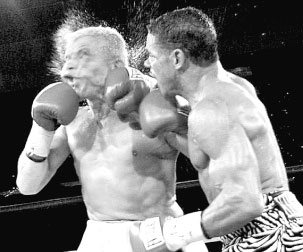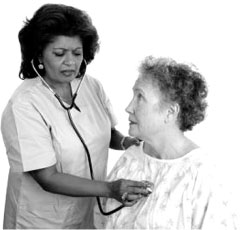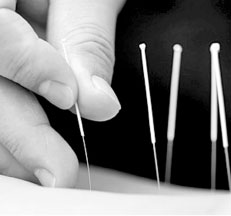|

Boxing may cause brain damage
 Olympic
boxers can exhibit changes in brain fluids after bouts, which indicates
nerve cell damage. This is shown in a study of 30 top-level Swedish
boxers that was conducted at the Sahlgrenska Academy at the University
of Gothenburg, Sweden, in collaboration with the Swedish Boxing
Federation, published in PLoS ONE. Olympic
boxers can exhibit changes in brain fluids after bouts, which indicates
nerve cell damage. This is shown in a study of 30 top-level Swedish
boxers that was conducted at the Sahlgrenska Academy at the University
of Gothenburg, Sweden, in collaboration with the Swedish Boxing
Federation, published in PLoS ONE.
It has been debated for quite some time whether Olympic boxing
(amateur boxing) is hazardous to the brain. Researchers at the
Sahlgrenska Academy, Gothenburg University, joined colleagues at the
Faculty of Health Sciences at Linköping University and the Swedish
Boxing Association in conducting a unique study of 30 top-level Swedish
boxers and 25 reference persons.
Brain injury similar to Alzheimer´s
The study shows that repeated blows to the head in the boxing ring
can produce a release of brain injury markers to the brain fluid,
similar to what is seen with after other types of head trauma, as well
as in neurological illnesses such as Alzheimer´s.
"Our study shows that after bouts, some of the boxers had elevated
concentrations of four different proteins in the brain fluid, which all
signal damage to the brain's nerve cells. Moreover, two of the proteins
were still elevated after a period of rest" says researcher Sanna
Neselius, who has led the study. Sanna Neselius has self been boxing at
elite level and was ranked as one of the best female boxers in the
world, both as olympic and professional boxer.
*Very few show symptoms
As many of 80 percent of the boxers exhibited protein changes that
indicate brain damage.
The boxers who participated in the study competed on the top-level of
Swedish boxing and all had fought at least 47 bouts. None of them had
lost on a knock-out, and only one of the boxers mentioned symptoms after
a bout (headache).
"The brain injury markers were elevated for 80 percent of the olympic
boxers directly after a bout as a result of minor brain damage. That the
brain fluid markers were elevated even after weeks of rest for some of
the boxers can be interpreted as the damage had yet not healed or that
some damage will remain, says Sanna Neselius.
Call for concussion guidelines
Sanna Neselius has now scheduled a meeting with the Swedish Boxing
Federation's board of directors to discuss the results. "We need to
discuss the results and how we can increase the medical safety for
boxers, both during training and in competition," says Neselius. "I
further hope that the results will be taken seriously by other martial
arts federations, where the safety regulations are not as well defined
as in boxing. The results may also be useful when discussing concussion
guidelines.
Blood test a future option
"Preferably, we would like to find a simple blood test that provides
the same information as our more advanced brain fluid examinations.
The capability does not presently exist, but can perhaps become an
option in the future with further and more extensive studies."
silobreaker.com
Global gender differences in treatment of heart disease
Three new studies from India, China and Middle East expose the extent
of the problem in new data presented at the World Congress of
Cardiology.
 Women
with acute coronary syndrome - (ACS) receive inferior or less aggressive
treatment compared to men, according to three large studies presented at
the World Congress of Cardiology. Women
with acute coronary syndrome - (ACS) receive inferior or less aggressive
treatment compared to men, according to three large studies presented at
the World Congress of Cardiology.
The CREATE registry study of 20,468 patients in India revealed that
relatively fewer women are admitted with ACS.
Moreover, these women are older, reach hospital later, have more risk
factors, receive inferior treatments and have worse outcomes.
While the BRIG project study of 3,168 patients in China concluded
that a substantial portion of women with ACS did not receive proper
treatment during hospitalisation compared with men.
Similarly, a study of 4,229 ACS patients in the Middle East found
that women tended to be admitted to hospital later than men and had more
comorbid disease.
These women received commonly used treatment less frequently than
men, although in the case of the Middle East study this did not appear
to impact in-patient mortality.
"These three studies paint a consistent picture around the world and
all serve to demonstrate that women with ACS are unfortunately not
receiving the same treatment as men," said Prof. Sidney C Smith Jr, MD,
President, World Heart Federation.
"This is something that has to be addressed as a matter of urgency."
Women and heart disease
Cardiovascular disease (CVD), which includes heart disease and stroke
is the biggest killer of women globally causing 8.6 million deaths
annually. Women in low-and middle-income countries who develop CVD are
more likely to die from it than comparable women in industrialised
nations. However, women do not perceive CVD as the greatest threat to
their health they still feel more threatened by cancer than they do by
CVD. The good news is that there are steps women can take to protect
their hearts. These include stopping smoking, engaging in physical
exercise, maintaining a healthy weight, and ensuring a healthy food
intake.
- healthnewsmed
Protein combination best for building muscle post-workout
At Experimental Biology 2012, Dr. Blake Rasmussen and colleagues
presented a new and first-of-its-kind clinical study: "Effect of Protein
Blend vs. Whey Protein Ingestion on Muscle Protein Synthesis Following
Resistance Exercise."
 The
results of the study suggest that a protein blend (combination of soy,
whey and casein) may be best to consume post-workout for building
muscle. The
results of the study suggest that a protein blend (combination of soy,
whey and casein) may be best to consume post-workout for building
muscle.
Proteins
Specifically, the blend of proteins in this study showed an increase
in a person's "anabolic window" (the amount of time it takes for
building muscle to occur post exercise).
"This study confirms that consuming a blend of proteins (soy, whey
and casein) versus whey protein alone provides a prolonged delivery of
amino acids to the muscles, making it optimal for consumption following
resistance exercise," said Dr. Rasmussen, professor and interim chair of
the Department of Nutrition; Metabolism at the University of Texas
Medical Branch and the senior author of this study.
"The results of the study are critical for sports nutrition consumers
and regularly active individuals."
Blend
The protein in the blend used in this study consisted of 25 percent
isolated soy protein, 25 percent isolated whey protein and 50 percent
casein.
This combination of protein blends was determined in a preclinical
study which was presented at Experimental Biology 2011.
Soy, whey and casein proteins are all absorbed at different rates
during digestion.
Whey protein is referred to as a "fast" protein because it is rapidly
absorbed whereas casein, a "slow" protein, requires several hours to be
digested. The ability of soy protein to deliver amino acids is
"intermediate," meaning concentrations in blood peak somewhat later
compared to whey, but its digestion rate is much quicker than casein.
Hence, the effect of all three of these proteins combined appears to
provide the extended release of amino acid delivery to the muscles.
"Your muscles don't recover in 30 minutes. It takes at least 24-48
hours for your muscles to recover after a resistance exercise," said
Greg Paul, global marketing director for sports nutrition and weight
management, Solae.
"The study showed that protein blends can provide amino acid delivery
for up to five hours, meaning if you consume a product or protein shake
with these blends, the prolonged effect will deliver essential amino
acids to feed your muscles until your next meal."
- MNT
Acupuncture can improve skeletal muscle atrophy
A team of Japanese researchers reveal study results at the
Experimental Biology 2012 meeting that show how acupuncture therapy
mitigates skeletal muscle loss and holds promise for those seeking
improved mobility through muscle rejuvenation.
 "It
is my hope that this study will demonstrate acupuncture's feasibility
with regard to improving health among the elderly and medical patients.
Our findings could identify acupuncture as the primary
nonpharmacological treatment to prevent skeletal muscle atrophy in the
future," says Akiko Onda, an acupuncturist and graduate student at the
Waseda University School of Sport Sciences, who has been conducting a
series of studies on skeletal muscle atrophy for the past four years. "It
is my hope that this study will demonstrate acupuncture's feasibility
with regard to improving health among the elderly and medical patients.
Our findings could identify acupuncture as the primary
nonpharmacological treatment to prevent skeletal muscle atrophy in the
future," says Akiko Onda, an acupuncturist and graduate student at the
Waseda University School of Sport Sciences, who has been conducting a
series of studies on skeletal muscle atrophy for the past four years.
Loss of skeletal muscle mass has a profound effect on the ability of
the elderly and the sick to engage in physical activity.
Because skeletal muscle has high plasticity, interventions such as
exercise training, improved nutrition and mechanical stimulation are
often recommended to prevent atrophy.
Unfortunately, these can be challenging goals for those who are
already frail or who have severe medical conditions. Onda said an
alternative nonpharmacological intervention is urgently required, and so
she and her collaborators in two labs at Waseda University decided to
explore how acupuncture affects skeletal muscle at the molecular level.
"The main focus of this study is changes in the mRNA expression
levels of muscle-specific atrophic genes such as atrogin-1," Onda says.
"Muscle mass and structure are determined by the balance between
protein degradation and synthesis."
The team showed that decreases in muscle mass in mice and in the mRNA
expression level of the E3 ubiquitin ligase atrogin-1 can be
significantly reversed by acupuncture. In spite of the World Health
Organization's endorsement of acupuncture and the widespread use of
acupuncture as a treatment for various diseases, acupuncture is still
regarded by many as obscure and suspicious, and its underlying molecular
mechanisms are almost completely unknown.
"Our results have uncovered one molecular mechanism responsible for
the efficacy of acupuncture treatment and clarified its usefulness in
preventing skeletal muscle atrophy in mice," Onda said.
"We hope to introduce acupuncture as a new strategy for preventing
skeletal muscle trophy in the future. Further investigations into its
molecular mechanisms will help to decrease the medical community's
suspicion of acupuncture and provide us with a better understanding of
how acupuncture treatment prevents skeletal muscle atrophy."
- humanhealthandscience
Bedwetting in older children
 Bedwetting
in older children is common, but it can be distressing. An article in
CMAJ (Canadian Medical Association Journal) outlines possible causes and
evidence for current treatments. Bedwetting
in older children is common, but it can be distressing. An article in
CMAJ (Canadian Medical Association Journal) outlines possible causes and
evidence for current treatments.
Bedwetting in children aged five years or older, also called
nocturnal enuresis, is common, although more common in boys. An American
study found a prevalence of bedwetting of 6.21 p.c. in boys compared
with 2.51 p.c. in girls.
Condition
There is also a strong genetic aspect to bedwetting, as a large
British study found a significantly higher likelihood of bedwetting if a
parent was a bedwetter.
Three conditions generally contribute to bedwetting: excessive urine
production at night, an overactive bladder and an inability to wake up
in response to the need to urinate. Although the condition itself is not
associated with a major illness, it is important for physicians to
conduct a physical exam to rule out any other causes. Urinalysis and
urine culture may be the only necessary tests as evidence shows that
other investigations are not particularly useful or cost effective.
"The most critical aspect of treatment is reassurance for the child,
who may experience low self-esteem," writes Dr. Darcie Kiddoo, Divisions
of Pediatric Surgery and Urology, University of Alberta, Edmonton,
Alberta.
"Parents must understand that, unlike daytime behaviour, nighttime
incontinence is not within the child's control."
Modifications
Treatment varies from lifestyle modifications to medication and
alternative therapies for which there is little evidence of
effectiveness.
Desmopressin a medication that works on the kidneys to reabsorb
urine, is successful in reducing nighttime water production but the
benefits disappear when the medication is stopped. Tricyclic
antidepressants can be effective in some children, but there are adverse
effects and few parents choose this option.
Bed alarms have shown the most long-term success. "A systematic
review found that after 10 weeks, 66 p.c. of children maintained 14
consecutive dry nights compared with only 4 p.c. of children with no
treatment," Dr. Kiddoo writes. The effect lasts after the device is no
longer used, but parental vigilance is required to help children wake up
if they do not hear the alarm.
Children eventually will outgrow the condition, with 15 p.c. stopping
without treatment each year.
- MNT
|

